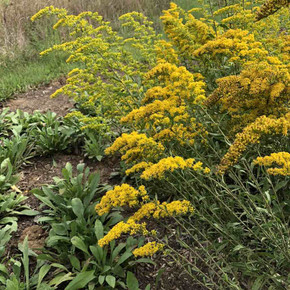
Bigelowia nuttallii - RAYLESS GOLDENROD
If you think there are no more unusual native plants, that turn to be good garden plants, then you haven't met this goldenrod.
Quite rare in cultivation and gardens, but tough, unique looking and very late blooming.
Fresh green leaves arranged in tufts, delicate fabulous yellow flowers.
Not demanding plant, that requires only sun and some drainage (sand, gravel mixed in).
Highly recommended by Mt. Cuba Center.
Blooming time: September-October
Size: usually only 8-10" tall (rarely = in ideal conditions up to 15") x 5-10" wide clumps, very slowly growing wide
USDA zones: 4/5 to 9 (in cold areas requires sharper drainage)
Culture: full sun, half sun, requires some drainage, so add sand or gravel to your existing soil. Average soil with average moisture to drier and drained soil. We grow this plant successfuly in clayish soil amended with sand and little bit of compost. Sandy, gravelly, rocky, gritty soils. Despite the fact it prefers acidic soils in nature, it was happy in out alkaline soil.
Avoid wet, waterlogged and too organic-rich soils.
Moisture Needs: medium to medium-dry, dry, very tolerant to summer droughts, heat and humidity
Origin: Texas, Georgia and Florida - grows on scattered locations from sandy/gravely seeps to rock outcrops areas, savannas, sandy savannas, exposed rocky and sandy spots. Often found on acidic soils.
Deer/rabbit resistant: yes/yes
Attracts Butterflies or Pollinators: important late source of nectar and pollen to native bees, wasps and other smaller insects
Attracts Hummingbirds: no
Plant combinations: Since it's smaller plant from open areas, it can't compete with large and vigorously growing companions. Plant of sunny dry edges, rock gardens, crevice gardens, any drained and drier soil, in combination with rocks, in troughs and arranged rock garden planters.
Good companions van be Anntenaria, Aster linariifolius, Dalea, Delosperma (Ice Plant), Dianthus, dwarf Echinacea cultivars (like 'Pixie Meadowbrite' for example), dwarf or small bearded Iris, Liatris microcephalla and other small liatris, small cultivars of Nepeta x faasenii, dwarf forms of Origanum vulgare, Penstemon, Salvia nemorosa 'Marcus', Stachys 'Densiflorus', Stachys minimus, shorter Sedum, Thymus, Satureja, and garden succulents, Sempervivum (Hens and Chickens), Sisyrinchium (preferably the cultivars that seed less), Thymus, Viola pedata and small sized grasses like Koleria cristata, smaller Sesleria, Schizachyrium 'Jazz', Sporobolus 'Tara' or Stipa tenuissima.
Pot size: square 3.5 " x 4" deep perennial pot
Picture copyright: Katharine Wagner-Reiss, Commons Wikpedia

Bigelowia nuttallii - RAYLESS GOLDENROD
If you think there are no more unusual native plants, that turn to be good garden plants, then you haven't met this goldenrod.
Quite rare in cultivation and gardens, but tough, unique looking and very late blooming.
Fresh green leaves arranged in tufts, delicate fabulous yellow flowers.
Not demanding plant, that requires only sun and some drainage (sand, gravel mixed in).
Highly recommended by Mt. Cuba Center.
Blooming time: September-October
Size: usually only 8-10" tall (rarely = in ideal conditions up to 15") x 5-10" wide clumps, very slowly growing wide
USDA zones: 4/5 to 9 (in cold areas requires sharper drainage)
Culture: full sun, half sun, requires some drainage, so add sand or gravel to your existing soil. Average soil with average moisture to drier and drained soil. We grow this plant successfuly in clayish soil amended with sand and little bit of compost. Sandy, gravelly, rocky, gritty soils. Despite the fact it prefers acidic soils in nature, it was happy in out alkaline soil.
Avoid wet, waterlogged and too organic-rich soils.
Moisture Needs: medium to medium-dry, dry, very tolerant to summer droughts, heat and humidity
Origin: Texas, Georgia and Florida - grows on scattered locations from sandy/gravely seeps to rock outcrops areas, savannas, sandy savannas, exposed rocky and sandy spots. Often found on acidic soils.
Deer/rabbit resistant: yes/yes
Attracts Butterflies or Pollinators: important late source of nectar and pollen to native bees, wasps and other smaller insects
Attracts Hummingbirds: no
Plant combinations: Since it's smaller plant from open areas, it can't compete with large and vigorously growing companions. Plant of sunny dry edges, rock gardens, crevice gardens, any drained and drier soil, in combination with rocks, in troughs and arranged rock garden planters.
Good companions van be Anntenaria, Aster linariifolius, Dalea, Delosperma (Ice Plant), Dianthus, dwarf Echinacea cultivars (like 'Pixie Meadowbrite' for example), dwarf or small bearded Iris, Liatris microcephalla and other small liatris, small cultivars of Nepeta x faasenii, dwarf forms of Origanum vulgare, Penstemon, Salvia nemorosa 'Marcus', Stachys 'Densiflorus', Stachys minimus, shorter Sedum, Thymus, Satureja, and garden succulents, Sempervivum (Hens and Chickens), Sisyrinchium (preferably the cultivars that seed less), Thymus, Viola pedata and small sized grasses like Koleria cristata, smaller Sesleria, Schizachyrium 'Jazz', Sporobolus 'Tara' or Stipa tenuissima.
Pot size: square 3.5 " x 4" deep perennial pot
Picture copyright: Katharine Wagner-Reiss, Commons Wikpedia
Customer Reviews
-
Adorable and Gorgeous!
This is the second one I bought because it’s just so good looking and does so well. The plants arrived in full flower and robust health. Excellent roots made the transition into the ground flawless. You’d think they’d been in ground for years. Everyone needs this cutie pie that is such an easy keeper!?
-
Plant quality
Very healthy looking.








